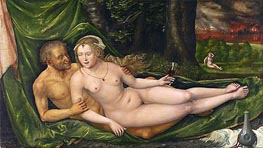
Albrecht Altdorfer Giclée Fine Art Prints
c.1480-1538
German Northern Renaissance Painter
Albrecht Altdorfer occupies a fascinating and somewhat unique place in the German Renaissance. Born in the 1480s, likely in Amberg, Altdorfer was shaped by the artistic milieu of Regensburg, where he would spend much of his life. While his exact early training remains a mystery, it’s clear that Altdorfer absorbed a variety of influences. What’s remarkable is how he synthesized these into something entirely his own. His work speaks not only of his time but of a profoundly personal vision - one that places nature, rather than man, at the heart of the narrative.
Altdorfer first made his mark around 1506 with his engravings and small paintings, but it was the commission for the monastery of Saint Florian in Linz, which occupied him for nearly a decade, that began to define his style. While he looked to Albrecht Dürer, Lucas Cranach, and even Italian engravers like Marcantonio Raimondi, Altdorfer developed a distinctive approach. His paintings are dense with detail, but they draw you into the landscape itself. Forests and mountains seem to possess their own life force, as though the natural world is as much a character as the human figures within it.
In many ways, Altdorfer’s "Battle of Alexander" (1529) epitomizes this shift in focus. Commissioned by Duke Wilhelm IV of Bavaria, the painting captures an epic historical event, but it’s the landscape that dominates. The battle is rendered in miniature, nearly overwhelmed by the cosmic sweep of sky and earth. Altdorfer transforms the scene into something more than historical documentation; it becomes a meditation on humanity’s place in the vastness of the natural world. His figures are often almost incidental, and it’s this perspective - where man is dwarfed by the forces of nature - that sets Altdorfer apart.
Altdorfer was not just an artist but a civic figure. He served on the council of Regensburg, became mayor in 1528, and his involvement in the expulsion of the Jewish community in 1519 is a reminder of the fraught political and religious currents of the time. His etchings of the synagogue and woodcuts depicting the cult image of the Schöne Maria reflect his engagement with the cultural shifts taking place in the city. But even in these works, his attention to architecture and atmosphere hints at his deeper fascination with space and place.
Altdorfer’s legacy, though sometimes overshadowed by his more famous contemporaries, is one of quiet but profound innovation. He treated landscape not as a backdrop but as a central force in his art, creating a nearly mystical connection between humanity and the natural world. His work invites a slower, more contemplative approach - it’s about immersing oneself in the environment he created, where every tree, mountain, and stream pulses with a life of its own. In Altdorfer’s hands, landscape painting moved beyond mere scenery into something more intimate and expansive, a reflection of a world much larger than ourselves.
Altdorfer first made his mark around 1506 with his engravings and small paintings, but it was the commission for the monastery of Saint Florian in Linz, which occupied him for nearly a decade, that began to define his style. While he looked to Albrecht Dürer, Lucas Cranach, and even Italian engravers like Marcantonio Raimondi, Altdorfer developed a distinctive approach. His paintings are dense with detail, but they draw you into the landscape itself. Forests and mountains seem to possess their own life force, as though the natural world is as much a character as the human figures within it.
In many ways, Altdorfer’s "Battle of Alexander" (1529) epitomizes this shift in focus. Commissioned by Duke Wilhelm IV of Bavaria, the painting captures an epic historical event, but it’s the landscape that dominates. The battle is rendered in miniature, nearly overwhelmed by the cosmic sweep of sky and earth. Altdorfer transforms the scene into something more than historical documentation; it becomes a meditation on humanity’s place in the vastness of the natural world. His figures are often almost incidental, and it’s this perspective - where man is dwarfed by the forces of nature - that sets Altdorfer apart.
Altdorfer was not just an artist but a civic figure. He served on the council of Regensburg, became mayor in 1528, and his involvement in the expulsion of the Jewish community in 1519 is a reminder of the fraught political and religious currents of the time. His etchings of the synagogue and woodcuts depicting the cult image of the Schöne Maria reflect his engagement with the cultural shifts taking place in the city. But even in these works, his attention to architecture and atmosphere hints at his deeper fascination with space and place.
Altdorfer’s legacy, though sometimes overshadowed by his more famous contemporaries, is one of quiet but profound innovation. He treated landscape not as a backdrop but as a central force in his art, creating a nearly mystical connection between humanity and the natural world. His work invites a slower, more contemplative approach - it’s about immersing oneself in the environment he created, where every tree, mountain, and stream pulses with a life of its own. In Altdorfer’s hands, landscape painting moved beyond mere scenery into something more intimate and expansive, a reflection of a world much larger than ourselves.
1 Albrecht Altdorfer Artworks

Giclée Canvas Print
$54.63
$54.63
SKU: 8678-ALA
Albrecht Altdorfer
Original Size:107.5 x 189 cm
Kunsthistorisches Museum, Vienna, Austria
Albrecht Altdorfer
Original Size:107.5 x 189 cm
Kunsthistorisches Museum, Vienna, Austria